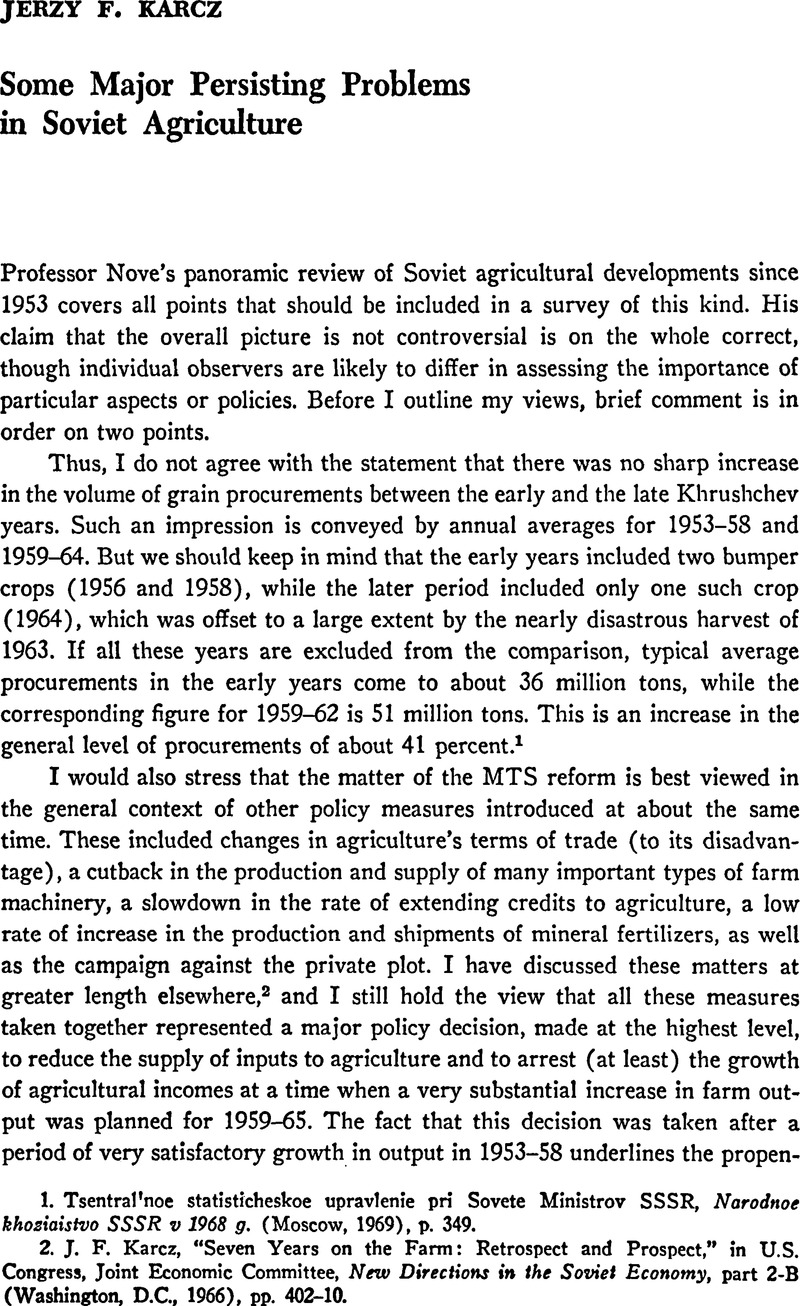No CrossRef data available.
Published online by Cambridge University Press: 27 January 2017

1. Tsentral'noe statisticheskoe upravlenie pri Sovete Ministrov SSSR, Narodnoe khosiaistvo SSSR v 1968 g. (Moscow, 1969), p. 349.
2. Karcz, J. F., “Seven Years on the Farm : Retrospect and Prospect,” in U.S. Congress, Joint Economic Committee, New Directions in the Soviet Economy, part 2-B (Washington, D.C., 1966), pp. 402–10.Google Scholar
3. Nar. khoz., 1964, p. 267, and Nar. khoz., 1968, pp. 334, 408.
4. I. Lukinov, “Tseny i planovo-ekonomicheskoe regulirovanie sel'skokhoziaistvennogo proizvodstva,” Voprosy ekonomiki, 1969, no. 1, p. 36.
5. Nar. khos., 1968, pp. 609, 618.
6. Ibid., p. 529. See also Christian Science Monitor, Apr. 13, 14, IS, 16, 1969, and New York Times, Apr. 5, 1969, sec. 4, p. 2.
7. Pravda, Apr. 10, 1966, and the speech by Gosplan chairman N. K. Baibakov, Pravda, Dec. 17, 1969. The planned increase in the consumption of grapes and fruit was to be 45 to 50 percent, while the corresponding range for meat and meat products was 20 to 25 percent. According to Baibakov, the expected increase for fruit and grapes will come to 18 percent and that for meat and meat products to 15 percent.
8. Shvydko, V, “Kompleksnaia mekhanizatsiia i elektrifikatsiia—vazhneishii put1 povysheniia proizvoditel'nosti truda v sel'skom khoziaistve,” Ekonomika sel'skogo khosiaistva, 1969, no. 2, p. 46 Google Scholar. According to Loza, P. S., Vosproisvodstvo i ispol'zovanie osnovnykh fondov v kolkhosakh (Moscow, 1969), p. 126 Google Scholar, 81 percent of all grain combines in the RSFSR were of the SK-4 type.
9. Karliuk, I, “Tekhnicheskii progress i ukreplenie material'notekhnicheskoi bazy sel'skogo khoziaistva,” Voprosy ekonomiki, 1969, no. 12, p. 63 Google Scholar. According to Shvydko, “Kompleksnaia mekhanizatsiia i elektrifikatsiia,” p. 49, plows were scrapped at the rate of 28 percent in Estonia and 22 percent in Kazakhstan in 1967. The corresponding figures for combines used for silage crops were 31 and 21 percent. See also Nar. khos., 1968, pp. 417-18, 422.
10. Shvydko, “Kompleksnaia mekhanizatsiia i elektrifikatsiia,” p. 43, and Loza, Vosproisvodstvo, p. 122.
11. Zhurikov, V, “Luchshe ispol'zovat1 mery material'nogo pooshchreniia kolkhoznikov,” Ekonomika sel'skogo khosiaistva, 1969, no. 1, p. 8 Google Scholar, and an account of the proceedings of the May 1969 conference in Ekonomika sel'skogo khosiaistva, 1969, no. 9, p. 121.
12. Ekonomika sel'skogo khosiaistva, 1969, no. 9, p. 122.
13. Zhurikov, “Luchshe ispol'zovat’ mery material'nogo pooshchreniia kolkhoznikov, “ p. 10; Voronov's speech was published in Leninskaia snamia, Mar. 24, 1970. I quote from a report by Paul Wohl in Christian Science Monitor, Apr. 14, 1970.
14. Smugiryn, M, “Rezervy snizheniia sebestoimosti kormov,” Ekonomika sel'skogo khosiaistva, 1969, no. 9, p. 57 Google Scholar, and L. Florentiev, “Puti povysheniia proizvoditel'nosti truda i snizheniia sebestoimosti,” ibid., p. 48.
15. Nar. khos., 1968, p. 411, and Kosynkin, A, “Glavnoe uslovie dal'neishego pod“ema ekonomiki khoziaistv,” Ekonomika sel'skogo khosiaistva, 1969, no. 3, p. 22.Google Scholar
16. Savitsky, F, “Povyshat’ ekonomicheskuiu effektivnost’ proizvodstva,” Ekonomika sel'skogo khosiaistva, 1969, no. 9, p. 6.Google Scholar
17. Ekonomika sel'skogo khosiaistva, 1969, no. 3, p. 124.
18. A. M., Emelianov, “Problemy i perspektivy razvitiia sel'skogo khoziaistva v svete reshenii oktiabrskogo (1968) Plenuma TsK KPSS,” Vestnik Moskovskogo universiteta, sen 8, no. 2 (1969), p. 9.Google Scholar
19. Nar. khos., 1968, pp. 10-11.
20. Wädekin, Karl-Eugen, “Manpower in Soviet Agriculture—Some Post-Khrushchev Developments and Problems,” Soviet Studies, 20, no. 3 (January 1969) : 290.CrossRefGoogle Scholar
21. Ibid., p. 285.
22. Bulochnikova, L, “Sel'skaia migratsiia i puti ego regulirovaniia,” Planovoe khosiaistvo, 1969, no. 8, pp. 73, 74Google Scholar. The agricultural labor force, measured in terms of average number employed, rose by 2.3 million from 1953 to 1958. It then declined by 2.1 million during the period of sluggish growth in 1959-64.
23. Wädekin, “Manpower in Soviet Agriculture,” pp. 291-92.
24. Bulochnikova, “Sel'skaia migratsiia,” p. 72.
25. Nar. khos., 1968, pp. 448, 454, 565, 691.
26. Wädekin, “Manpower in Soviet Agriculture/’ pp. 293-94, and Nar. khos., 1968, pp. 448, 454.
27. For example, the complaints about restrictions made at the session of the Latvian Central Committee and reported in Pravda, Jan. 21, 1970.
28. Sel'skaia shizn', July 3, 1970. See also ibid., July 4, 18, 19, 21, and 25 and Aug. 7, 1970.